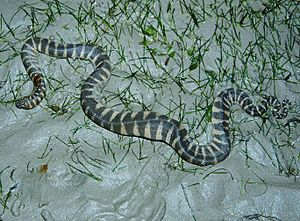Acrochordus granulatus facts for kids
Quick facts for kids Acrochordus granulatus |
|
|---|---|
 |
|
| Conservation status | |
| Scientific classification | |
| Genus: |
Acrochordus
|
| Species: |
granulatus
|
| Synonyms | |
|
|
The Acrochordus granulatus is a unique type of snake. You can find it in the waters from India across Southeast Asia to the Solomon Islands. People often call it the little file snake, marine file snake, or little wart snake. This snake spends its whole life in water and can barely move on land. There are no different types (subspecies) of this snake known today.
Contents
What Makes This Snake Special?
The Acrochordus granulatus is the smallest of the three snakes in its family, called Acrochordidae. That's why it's known as the "little file snake." It's also the only snake in its family that lives permanently in river mouths (estuaries) and coastal seas. This gives it another name: the "marine file snake."
Living in Water
All snakes in the Acrochordus group live completely in water. They are almost helpless if they end up on land. Like its relatives, the Acrochordus granulatus has special scales that feel rough, almost like a file. These scales have tiny bumps called tubercles. These tubercles have nerve endings that help the snake feel water movements. This is like an extra sense, helping them find prey.
How It Swims
The Acrochordus granulatus also has a tail that is flat from side to side. It can flatten its body from top to bottom to help it swim even better. These snakes are the most "marine" (sea-loving) of their family. They have special salt glands under their tongue. These glands are similar to those found in true sea snakes. They help the snake deal with salt water.
Staying Hydrated
Even with these glands, these snakes can still get dehydrated in the ocean. They need fresh water to drink. They find this by drinking from "freshwater lenses." These are layers of fresh water that float on top of the salt water. True sea snakes also use this trick to get fresh water. Female Acrochordus granulatus snakes are usually a bit bigger than the males.
Where Does This Snake Live?
You can find the Acrochordus granulatus in many places. Its home stretches from both coasts of India through Southeast Asia. It also lives in the Indo-Australian Archipelago and northern Australia, reaching all the way to the Solomon Islands.
Countries and Regions
This includes countries like Bangladesh, Myanmar, and Sri Lanka. It also lives in the Andaman Islands and Nicobar Islands. You can find it in Thailand, Cambodia, Vietnam, and China (specifically Hainan). It's also in the Philippines (like Luzon and Cebu). Other places include Malaysia and Indonesia (such as Sumatra, Java, and Borneo). It lives in Papua New Guinea and the Solomon Islands. Along the coast of northern Australia, it's found in the Northern Territory and eastern Queensland.
What Does It Eat?
Scientists have studied what the Acrochordus granulatus eats. In places like the Straits of Malacca, they mostly eat certain types of fish. These include Gobiodei, Eleotridae, and Trypauchenidae. They also eat small crustaceans, which are like tiny crabs or shrimp.
Since these snakes live in so many different places, their diet probably changes from one region to another. When kept in zoos or aquariums, they are not picky eaters. They will eat many different kinds of fish.


